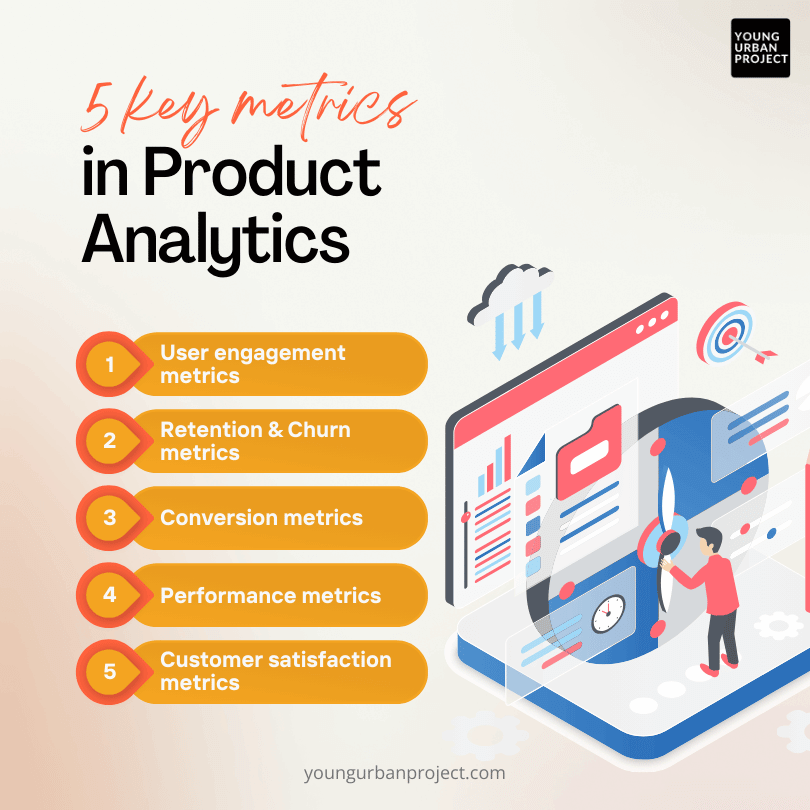Any product business (or any business for the matter) looking to establish and grow needs to leverage the power of product analytics from very early on in the product lifecycle. It helps product businesses make informed decisions, improve products, and boost customer satisfaction.
By analyzing product data, businesses can gain valuable insights that drive decision-making, improve product performance, and enhance customer satisfaction. This comprehensive guide will explore how to use product analytics to optimize business strategies, featuring real-world examples to illustrate key concepts.
Table of Contents
Introduction to Product Analytics
Product analytics is the systematic approach to collecting, analyzing, and interpreting data related to a product’s performance and user interactions. This process helps businesses understand how their products are being used, identify areas for improvement, and make data-driven decisions to enhance product quality and user experience.
By leveraging product analytics, companies can gain valuable insights into user behavior, measure the effectiveness of features, and optimize their strategies to meet customer needs and business goals. In essence, product analytics is a critical tool for driving product innovation, improving customer satisfaction, and achieving sustainable business growth.
The Importance of Product Analytics in Business Strategy
Product analytics plays a pivotal role in shaping and refining business strategies by providing valuable insights into how products are performing and how customers are interacting with them. Here’s why product analytics is crucial for modern businesses:
1. Understanding User Behavior
Product analytics allows businesses to gain deep insights into user behavior patterns. By analyzing data such as user interactions, feature usage, and navigation paths, companies can understand how customers engage with their products. This understanding helps in identifying popular features, areas of improvement, and potential bottlenecks that affect user experience.
2. Improving Product Features
By closely monitoring product analytics, businesses can determine which features are most valued by customers and which ones may need enhancement or modification. This data-driven approach ensures that product development efforts are aligned with customer preferences and market demands, leading to more competitive and user-friendly products.
3. Enhancing Customer Satisfaction
A key benefit of product analytics is its ability to pinpoint areas where customers may be experiencing difficulties or dissatisfaction. By identifying pain points through data analysis, businesses can proactively address issues, improve usability, and enhance overall customer satisfaction. This proactive approach not only retains existing customers but also fosters loyalty and positive word-of-mouth.
4. Optimizing Marketing Efforts
Product analytics provides insights that can significantly impact marketing strategies. By understanding user demographics, behavior patterns, and preferences, businesses can tailor marketing campaigns to target specific customer segments more effectively. This targeted approach improves campaign ROI and ensures that marketing efforts resonate with the intended audience.
5. Driving Business Growth
Ultimately, product analytics enables businesses to make informed decisions that drive growth. By leveraging data to identify market trends, customer needs, and competitive insights, companies can seize opportunities, innovate strategically, and stay ahead of the competition. Whether optimizing product performance, refining marketing strategies, or identifying new revenue streams, product analytics empowers businesses to achieve sustainable growth and long-term success.
Also Read: Key Product Management KPIs & Metrics
Key Metrics in Product Analytics

Product analytics relies on several key metrics to measure and evaluate the performance of a product. These metrics provide valuable insights into user behavior, product effectiveness, and overall business success. Here are some essential metrics commonly used in product analytics:
1. User Engagement Metrics
User engagement metrics assess how actively users interact with a product. These metrics include:
Active Users: The number of users who actively use the product within a specific timeframe.
Session Duration: The average time users spend interacting with the product during a single session.
Frequency of Use: How often users access the product over a given period.
Monitoring these metrics helps businesses gauge user interest, measure product stickiness, and identify opportunities to enhance engagement.
2. Retention and Churn Metrics
Retention and churn metrics focus on user retention rates and churn rates, which are critical indicators of product sustainability and customer loyalty. Key metrics include:
Retention Rate: The percentage of users who continue to use the product over time.
Churn Rate: The percentage of users who stop using the product within a specified period.
Understanding retention and churn rates helps businesses assess user satisfaction, identify reasons for customer attrition, and implement strategies to improve retention.
3. Conversion Metrics
Conversion metrics measure how effectively a product converts users into customers or leads. These metrics include:
Conversion Rate: The percentage of users who complete a desired action, such as signing up for a trial or making a purchase.
Funnel Drop-off Rates: The rate at which users abandon the conversion process at different stages of the sales funnel.
Optimizing conversion metrics involves analyzing user behavior, identifying conversion barriers, and implementing targeted strategies to improve conversion rates.
4. Performance Metrics
Performance metrics assess the operational and technical performance of a product. Key metrics include:
Page Load Time: The time it takes for web pages or app screens to load.
Error Rates: The frequency of errors encountered by users while using the product.
Uptime and Availability: The percentage of time the product is accessible and operational.
Monitoring performance metrics helps ensure product reliability, optimize user experience, and mitigate technical issues that could impact user satisfaction.
5. Customer Satisfaction Metrics
Customer satisfaction metrics measure how satisfied users are with the product and their overall experience. These metrics include:
Net Promoter Score (NPS): Measures the likelihood of users recommending the product to others.
Customer Feedback Scores: Ratings and qualitative feedback provided by users through surveys or feedback forms.
Support Ticket Resolution Time: The average time taken to resolve customer support tickets.
Implementing Product Analytics: Step-by-Step Guide
Implementing product analytics requires a strategic approach. Follow these steps to effectively use product analytics in your business:
1: Define Your Goals
Determine what you want to achieve with product analytics. Your goals might include increasing user engagement, reducing churn rate, or improving specific features.
2: Identify Key Metrics
Based on your goals, identify the key metrics that will provide the insights you need. Ensure these metrics align with your overall business objectives.
3: Collect Data
Use analytics tools to collect data from various sources, such as user interactions, sales data, and customer feedback. Ensure data accuracy and consistency.
4: Analyze Data
Analyze the collected data to identify trends, patterns, and insights. Use data visualization techniques to make the information more accessible.
5: Take Action
Based on your analysis, make informed decisions to optimize your product and business strategies. Implement changes, monitor their impact, and adjust as needed.
Tools and Technologies for Product Analytics
In the realm of product analytics, leveraging the right tools and technologies is essential for gathering, analyzing, and deriving meaningful insights from data. These tools not only streamline the analytics process but also enable businesses to make informed decisions that drive growth and innovation. Here are some key tools and technologies commonly used for product analytics:
1. Google Analytics
Google Analytics is a powerful web analytics tool that provides comprehensive insights into website and app performance. It tracks user interactions, measures conversions, and offers detailed reports on user behavior and demographics. Businesses can use Google Analytics to monitor traffic patterns, analyze user engagement, and optimize marketing strategies based on data-driven insights.
2. Mixpanel
Mixpanel specializes in product analytics for web and mobile applications. It tracks user actions, events, and behaviors in real time, allowing businesses to understand how users interact with their products. Mixpanel provides funnel analysis, cohort analysis, and retention reports to help businesses optimize user onboarding, improve feature adoption, and enhance overall user experience.
3. Amplitude
Amplitude is another robust analytics platform that focuses on behavioral analytics for digital products. It helps businesses analyze user behavior, measure product adoption, and segment users based on their actions and characteristics. Amplitude offers features like user journey analysis, A/B testing, and behavioral cohort analysis, empowering businesses to drive product improvements and growth strategies.
4. Heap
Heap is an automatic event-capturing tool that simplifies product analytics by automatically collecting user interactions without requiring manual tracking setup. It captures every user action on web and mobile applications, providing businesses with detailed insights into user behavior, conversion paths, and feature usage. Heap’s visual editor and retroactive analysis capabilities enable businesses to explore data retroactively and uncover valuable insights without predefined questions.
5. Tableau
Tableau is a data visualization tool that helps businesses transform complex datasets into interactive and easy-to-understand visualizations. It allows users to create dashboards and reports that showcase key metrics, trends, and patterns derived from product analytics data. Tableau’s drag-and-drop interface and powerful analytics capabilities enable businesses to visualize trends, share insights, and make data-driven decisions effectively.
6. Power BI
Microsoft Power BI is a business analytics tool that enables businesses to visualize and share insights from product analytics data. It integrates with various data sources and provides interactive dashboards, reports, and data connectors. Power BI offers robust data modeling capabilities, AI-powered insights, and real-time analytics, empowering businesses to monitor performance, identify trends, and drive business growth through data-driven decision-making.
7. Looker
Looker is a data analytics platform that offers business intelligence and data visualization capabilities. It allows businesses to explore and analyze data from multiple sources, create customized reports, and share insights across teams. Looker’s data modeling and exploration features enable businesses to gain a deeper understanding of product performance, customer behavior, and operational metrics, driving strategic decision-making and business optimization.
Challenges and Best Practices
Challenges
Data Privacy: Ensuring data privacy and compliance with regulations such as GDPR.
Data Integration: Integrating data from multiple sources can be complex and time-consuming.
Interpreting Data: Analyzing large volumes of data requires expertise and the right tools.
Best Practices
Focus on Key Metrics: Concentrate on metrics that align with your business goals.
Use Data Visualization: Present data in a visually appealing manner to facilitate understanding.
Maintain Data Quality: Ensure data accuracy and consistency by regularly auditing your data sources.
Stay Compliant: Adhere to data privacy regulations and best practices.
Conclusion
Product analytics plays a crucial role in optimizing business strategies. By understanding how to use product analytics, businesses can make data-driven decisions that enhance product performance, improve customer satisfaction, and drive growth.
Implementing product analytics involves defining goals, identifying key metrics, collecting and analyzing data, and taking informed actions. Using the right tools and adhering to best practices can help overcome challenges and maximize the benefits of product analytics.
By leveraging product analytics, businesses can gain a competitive edge and achieve long-term success.
If you want to get get daily tips & tricks follow us on Instagram.

